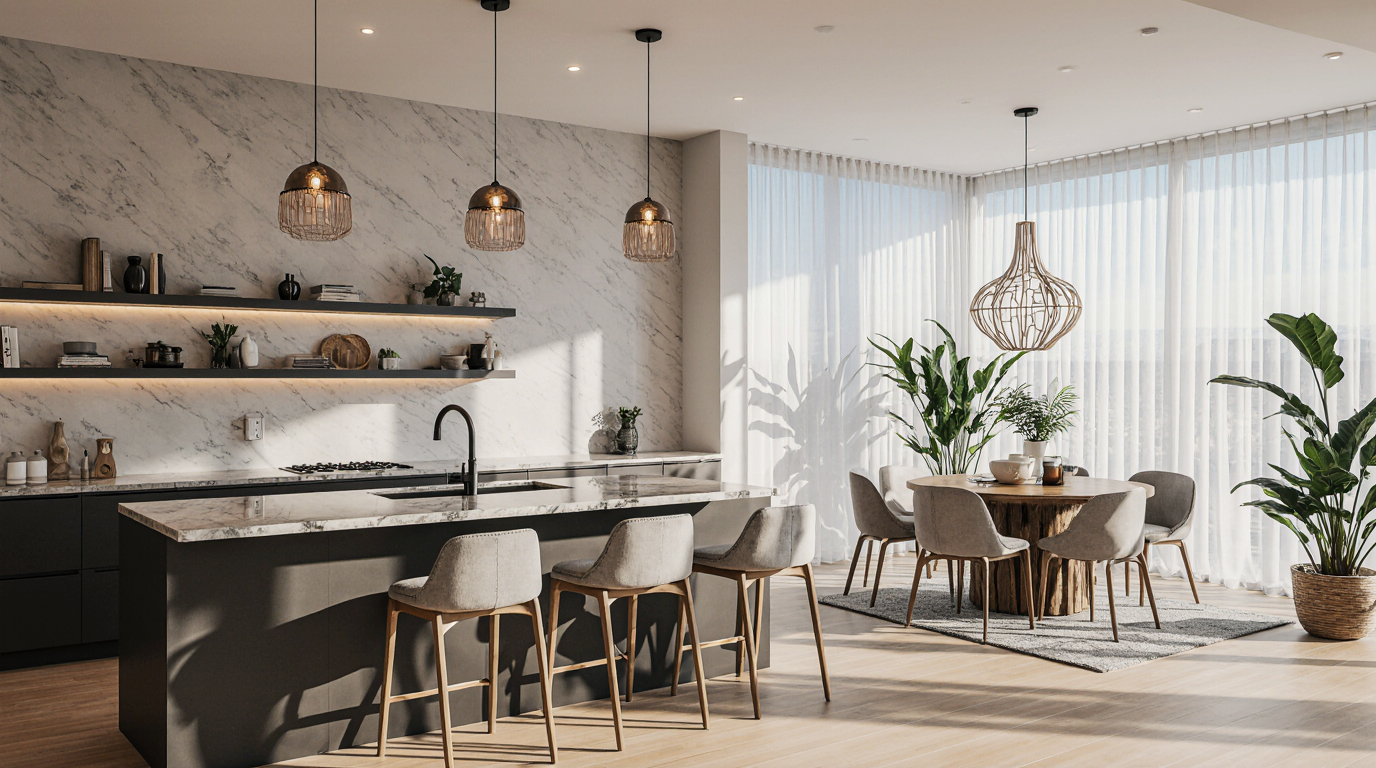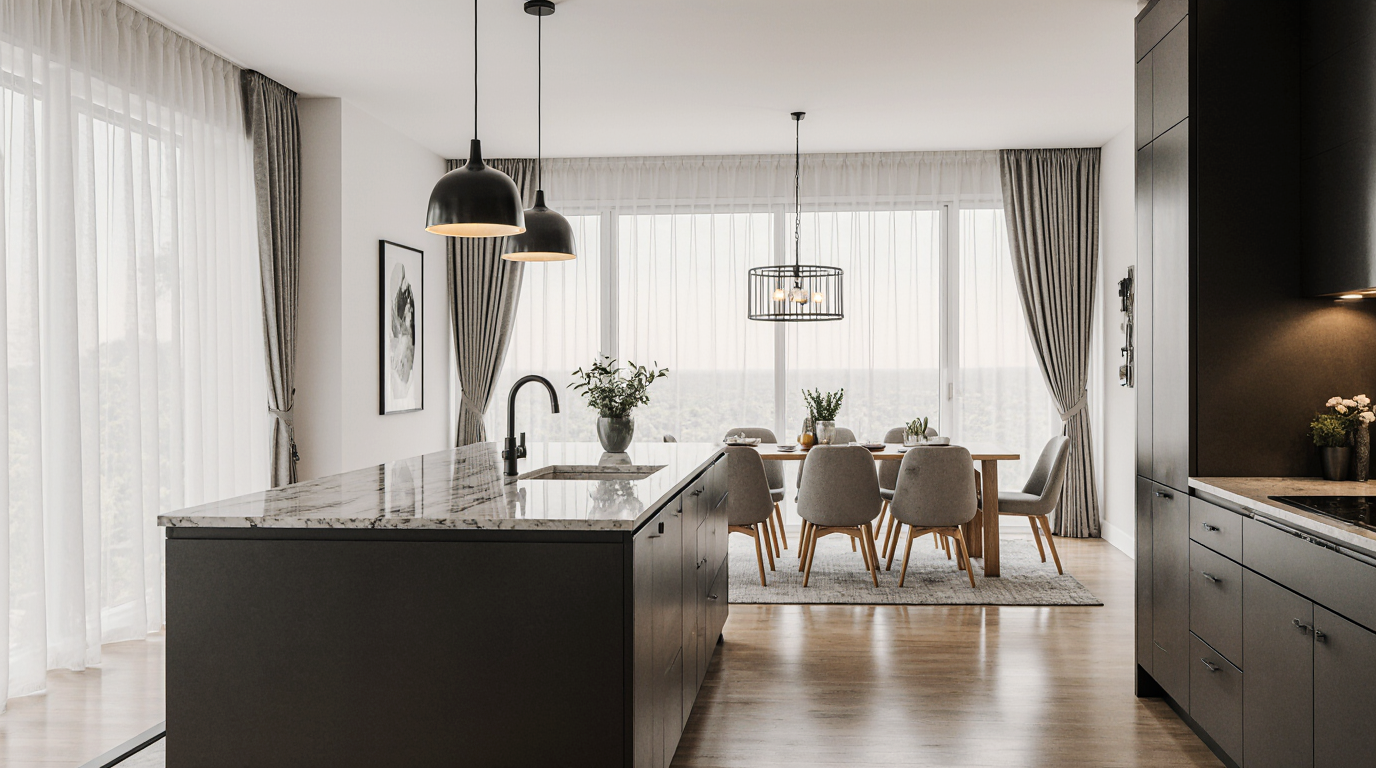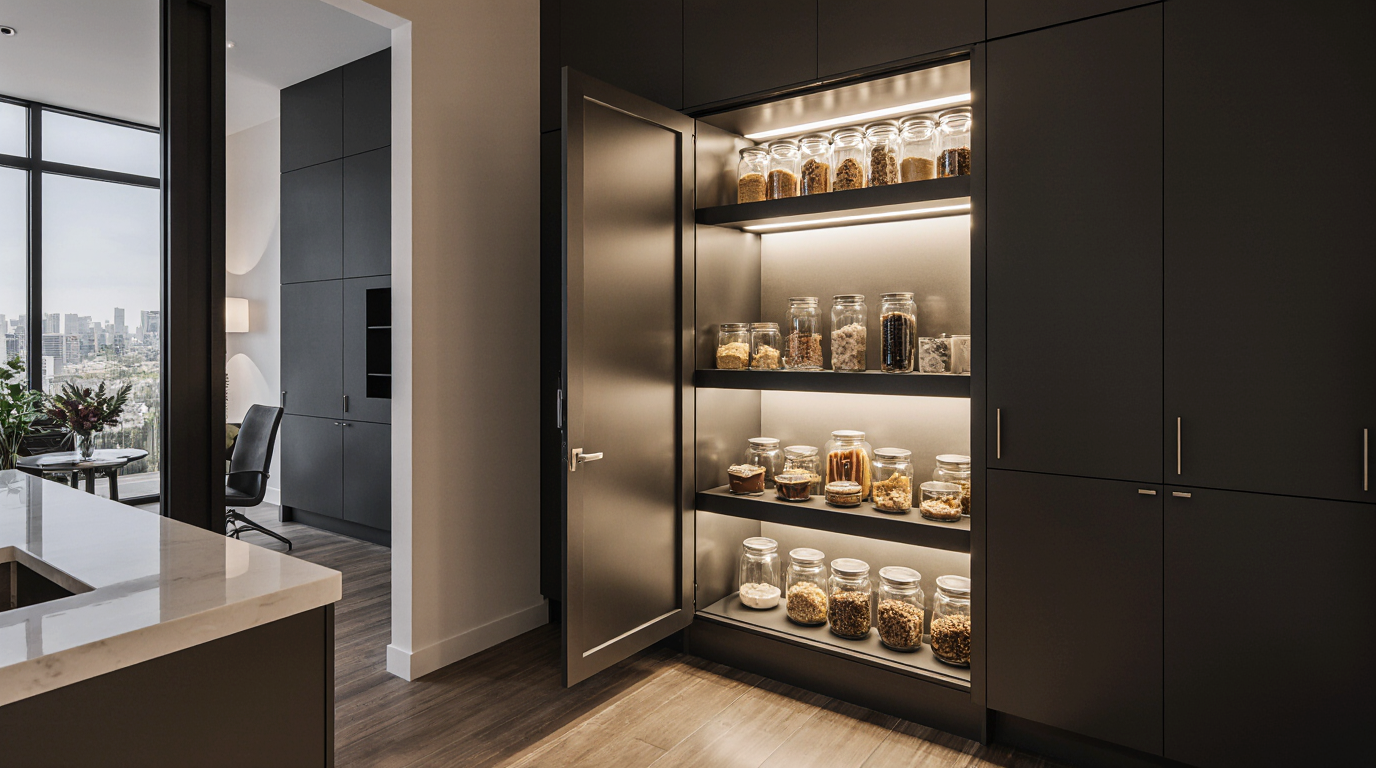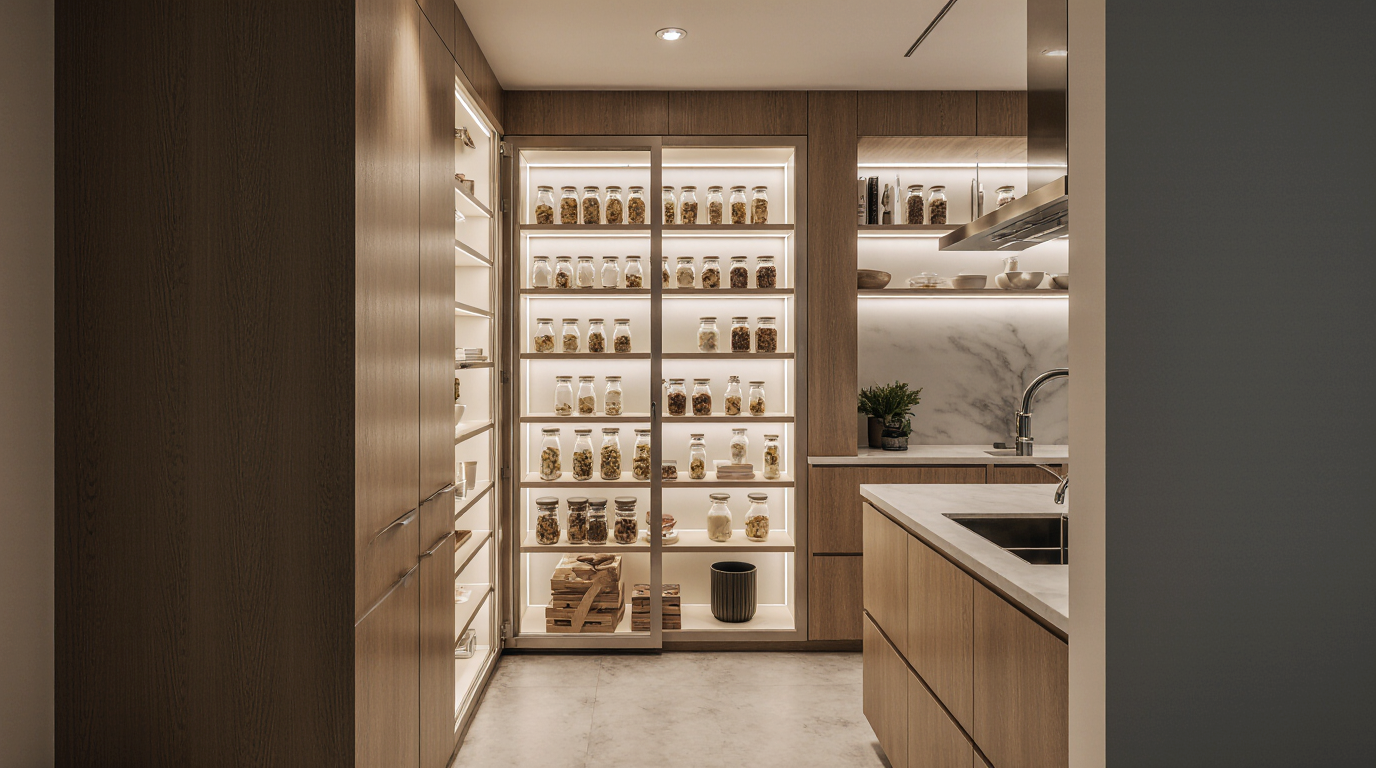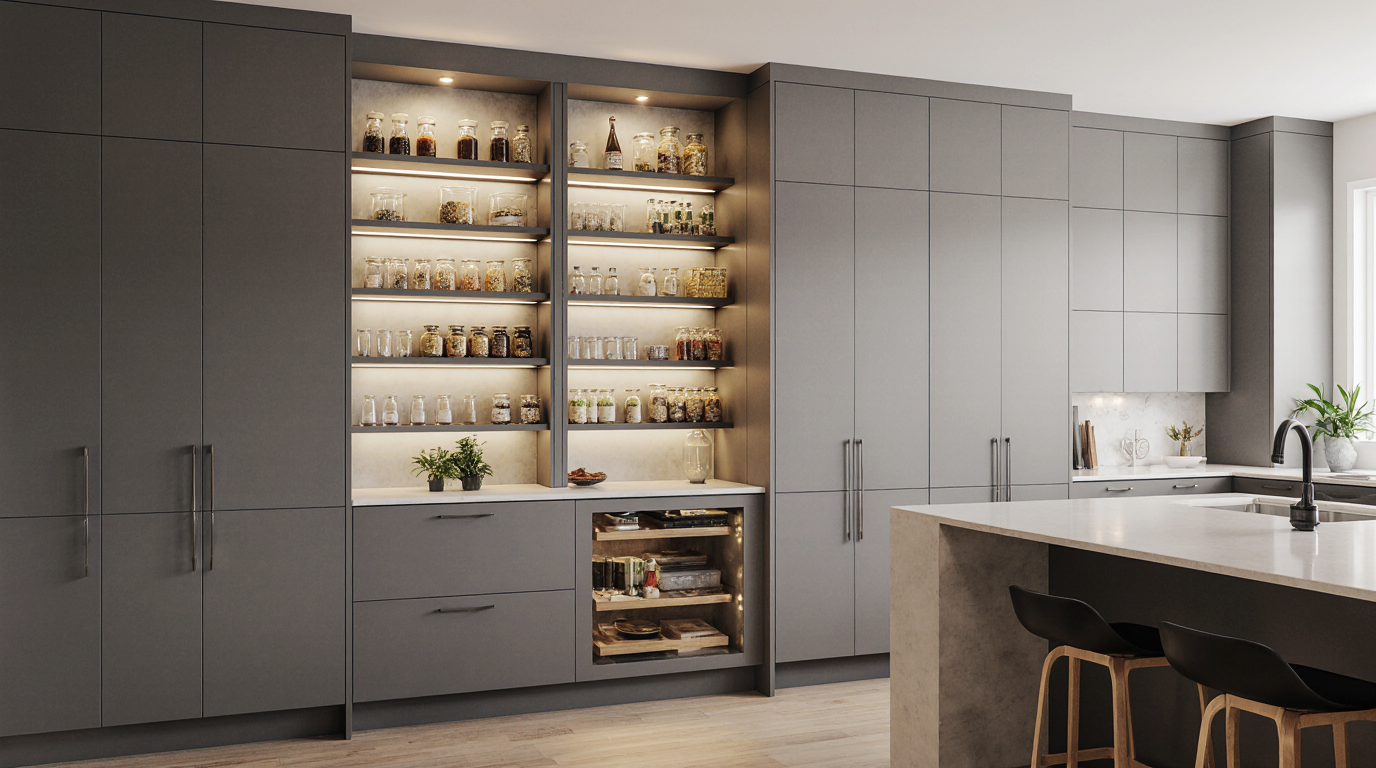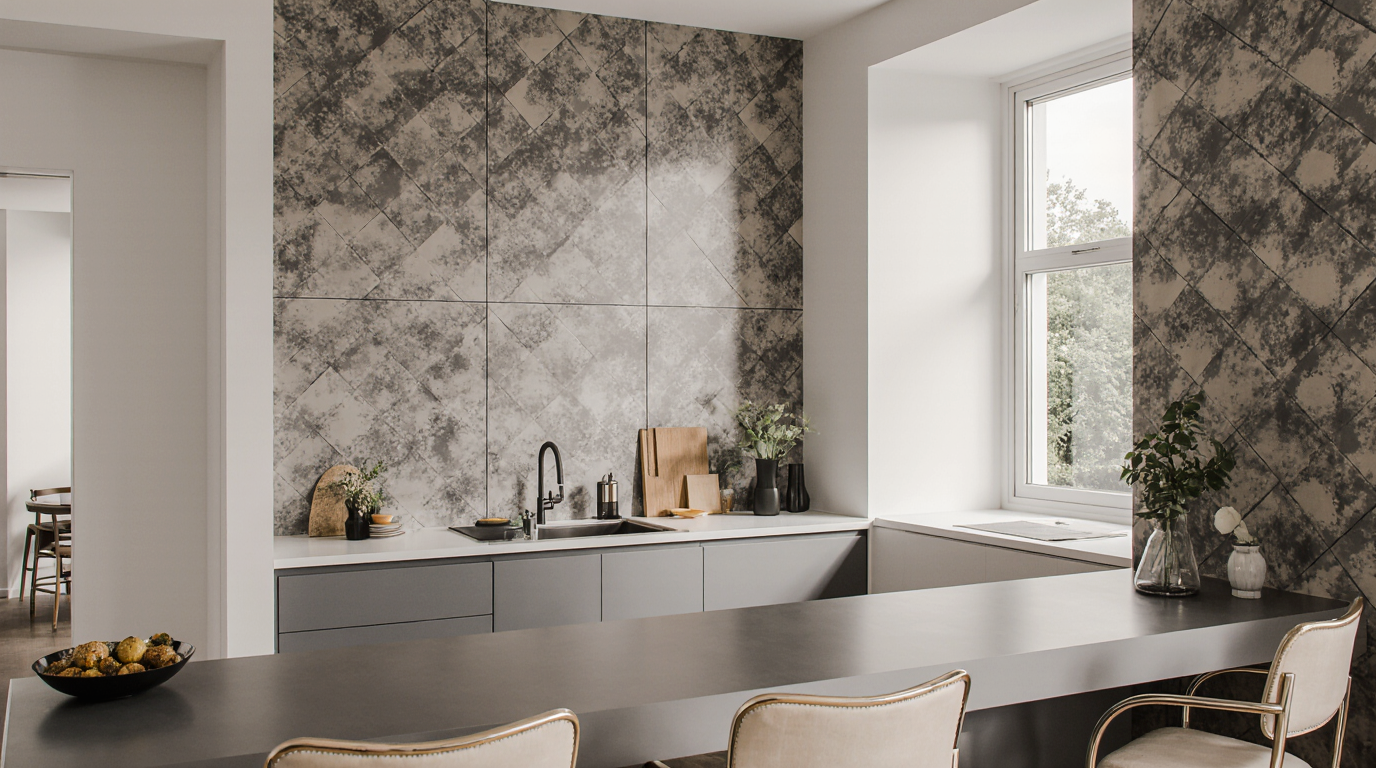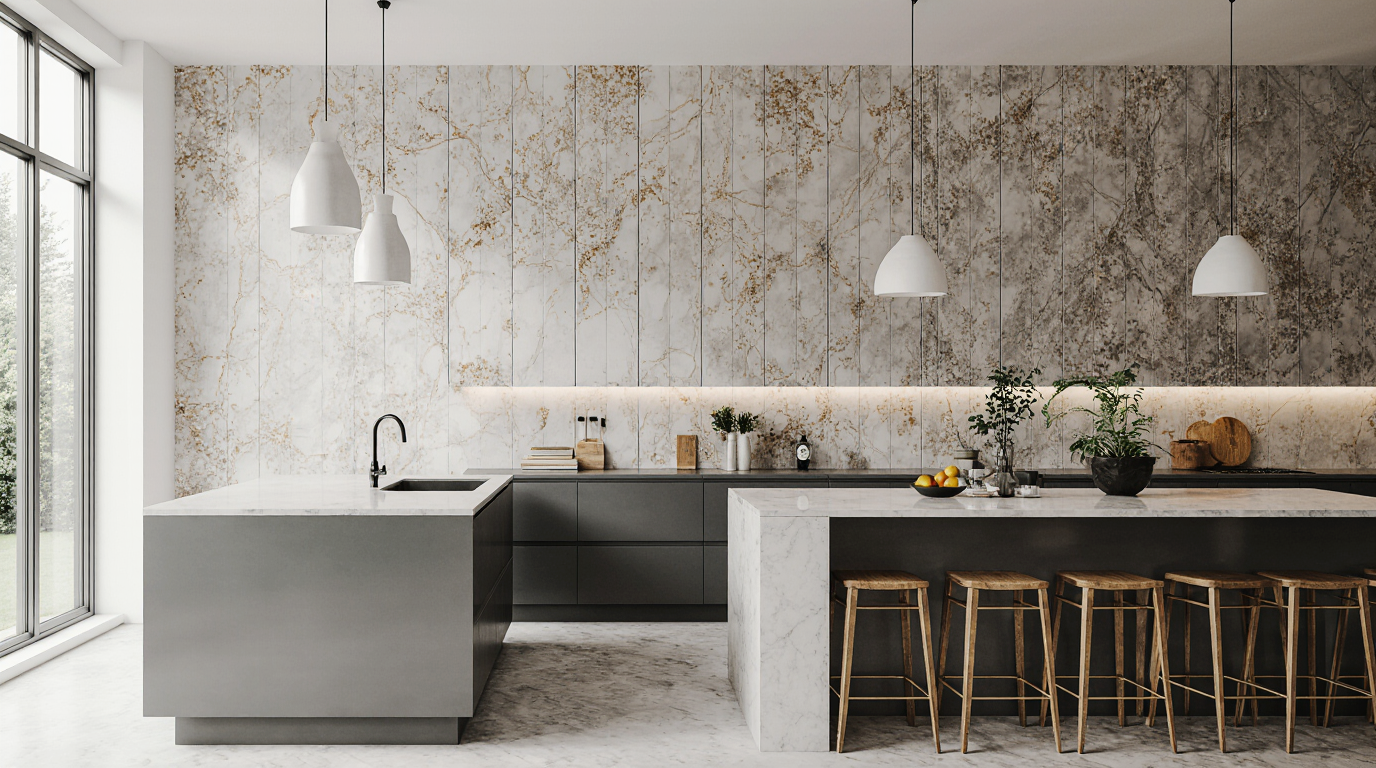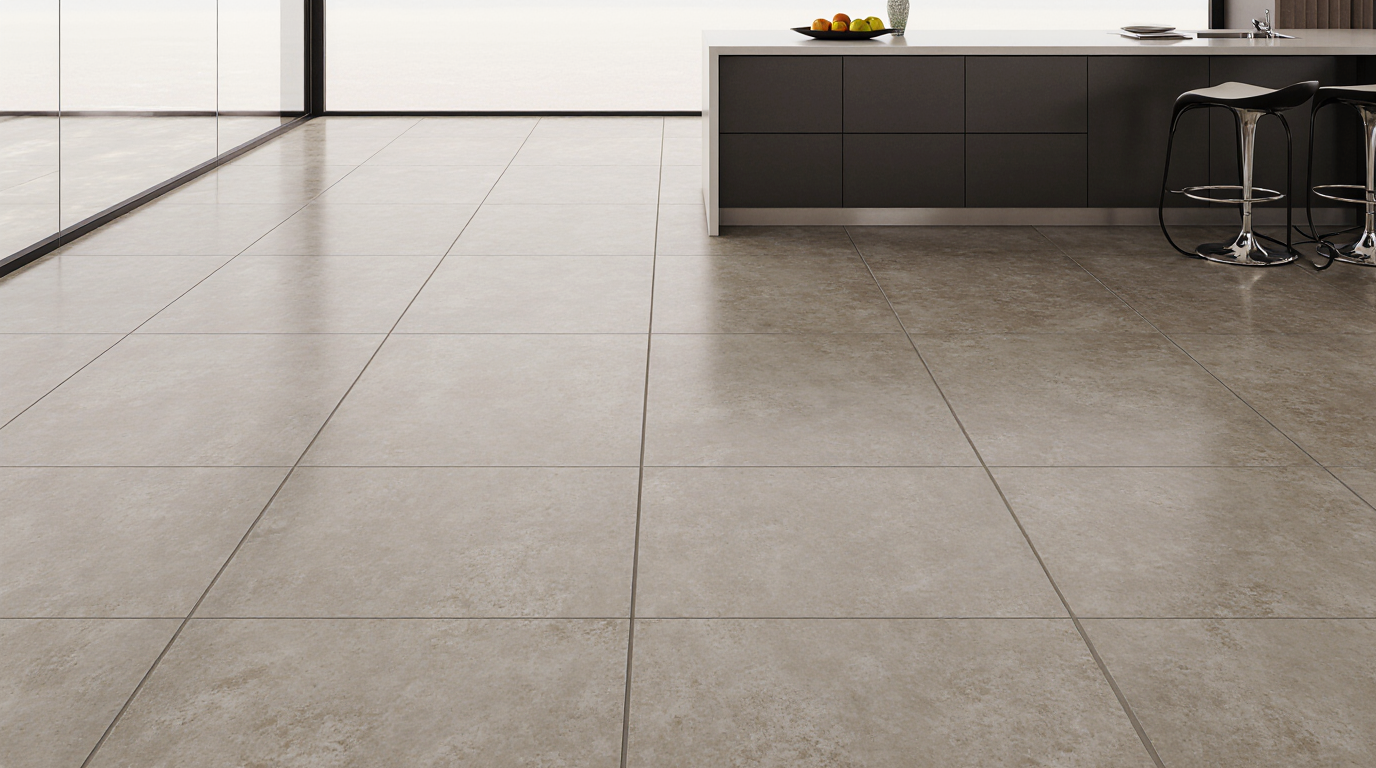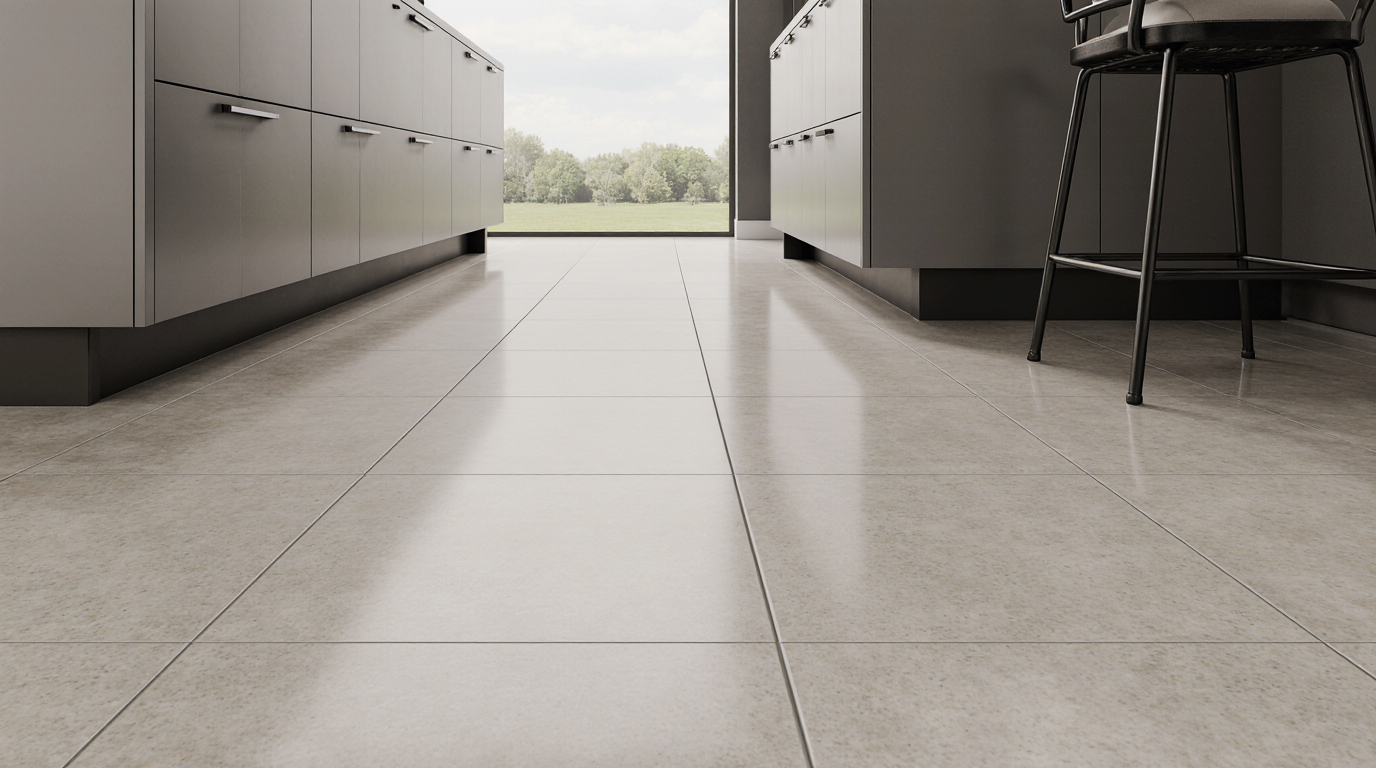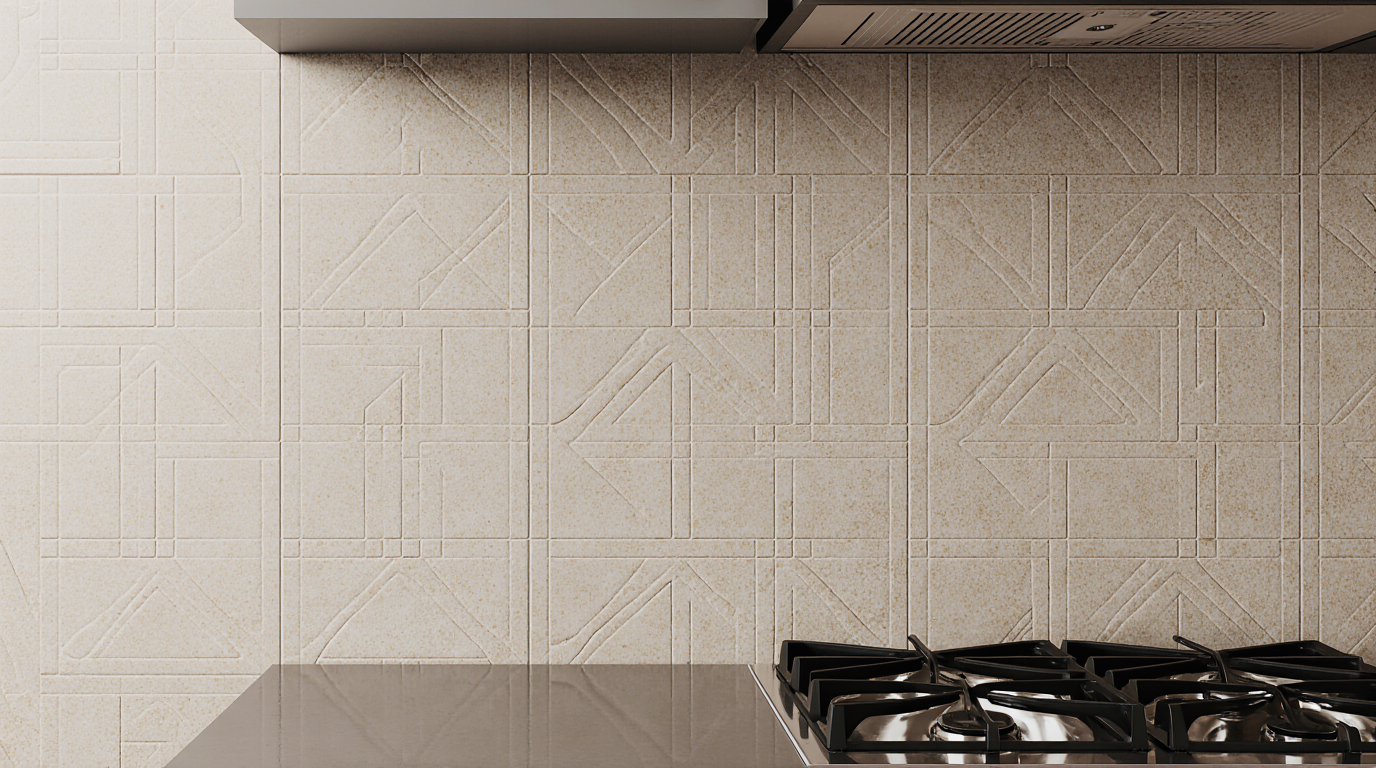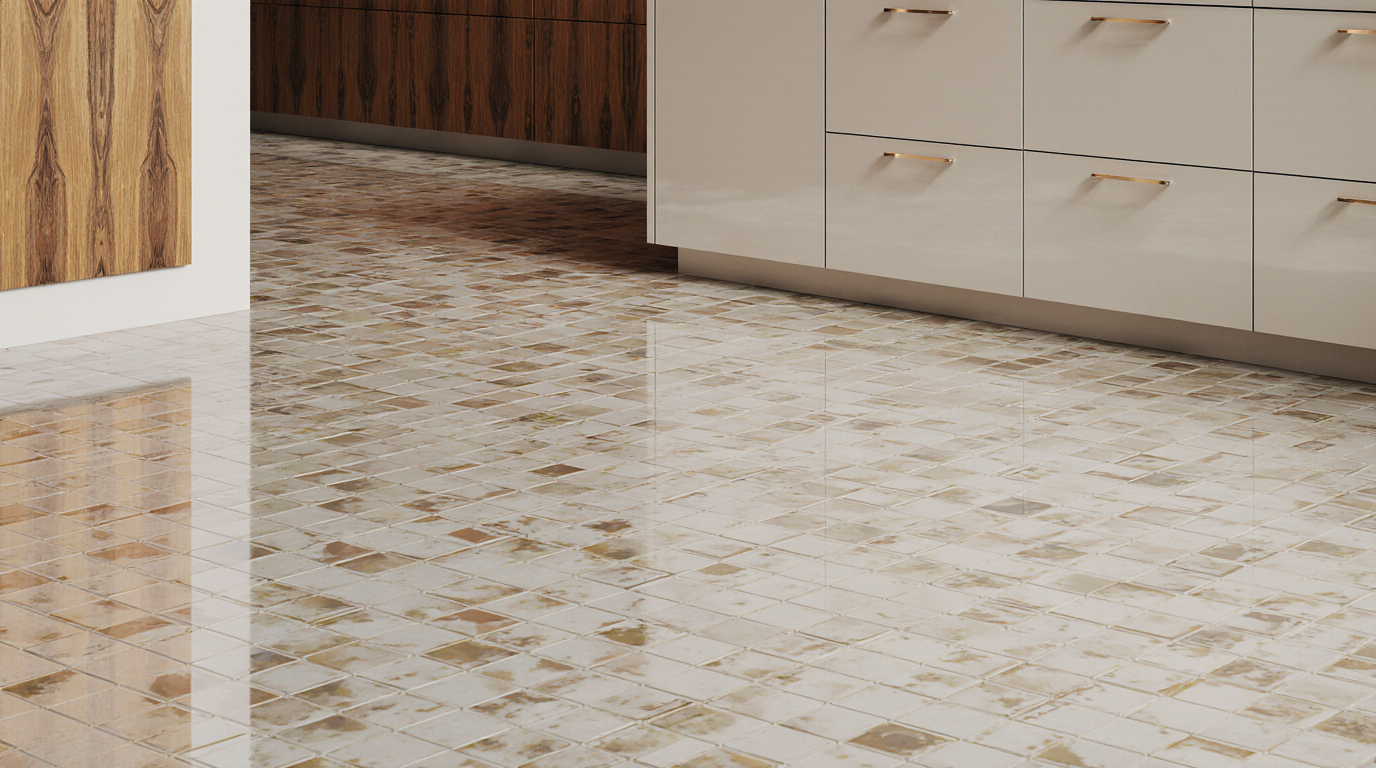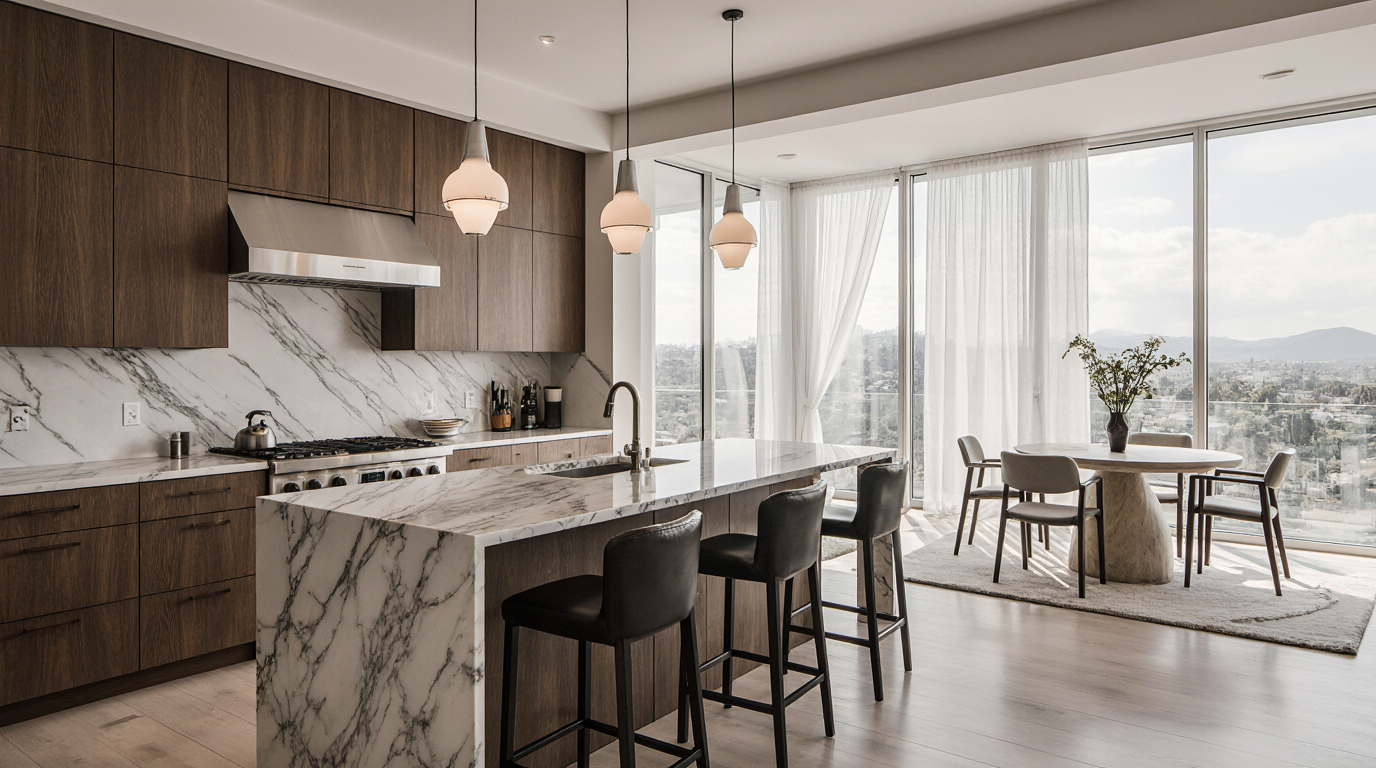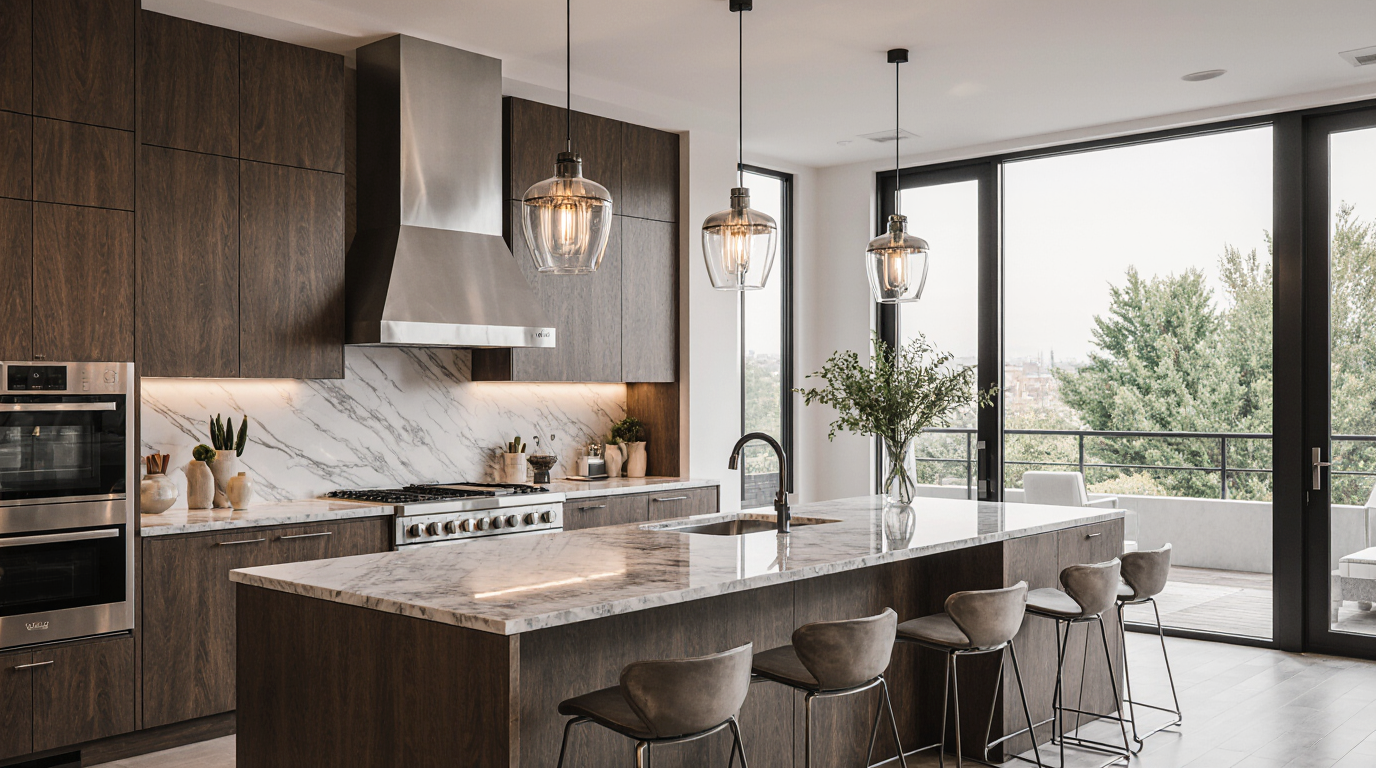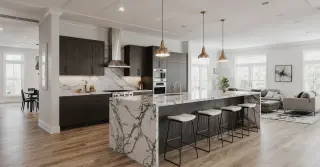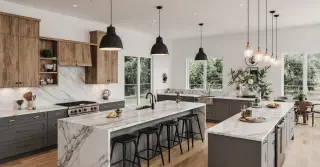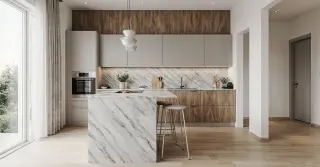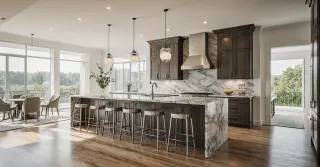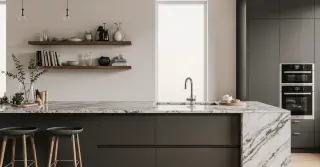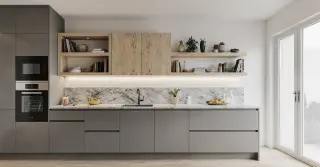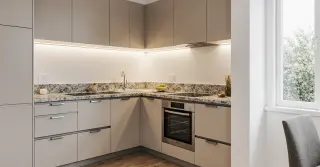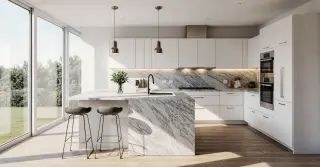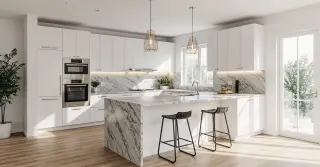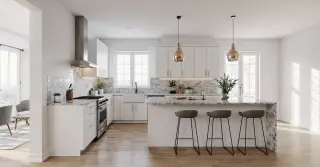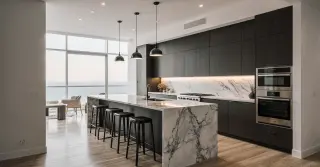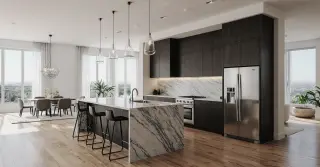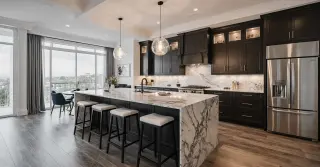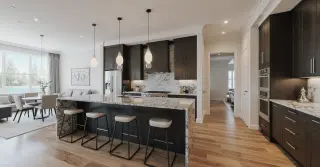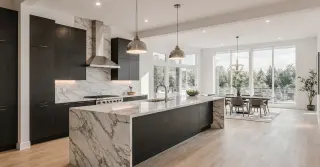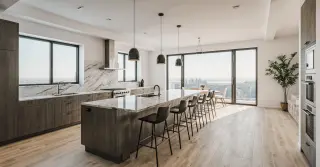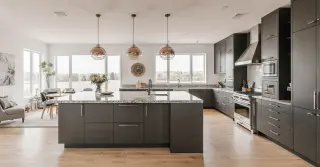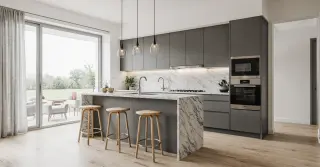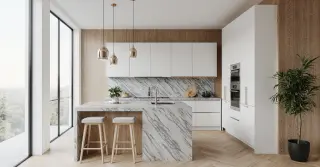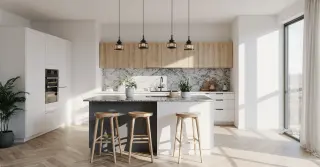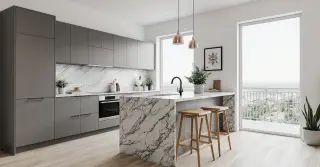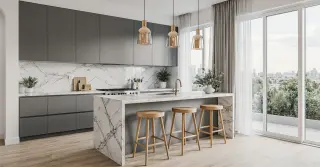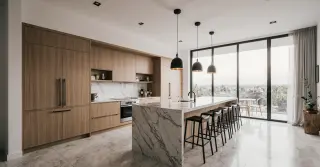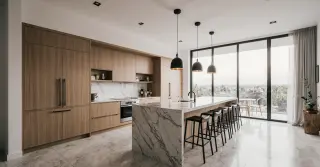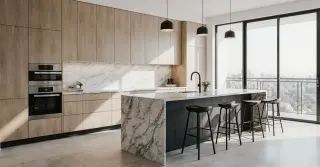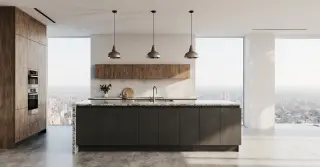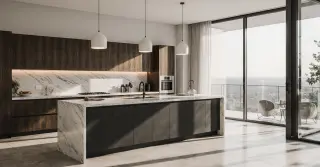Kitchen Design
The modern kitchen is truly the true heart of the home, evolving past a mere cooking space to become a central nexus for family life, social gatherings, and everyday activities. A successful kitchen design project demands the perfect marriage between aesthetic vision and practical ergonomics, ensuring the space not only looks magnificent but also enhances the daily rhythm of life.
The modern kitchen is truly the true heart of the home, evolving past a mere cooking space to become a central nexus for family life, social gatherings, and everyday activities. A successful kitchen design project demands the perfect marriage between aesthetic vision and practical ergonomics, ensuring the space not only looks magnificent but also enhances the daily rhythm of life.
The core principle guiding an efficient kitchen layout rests on the adherence to the classic, yet ever-relevant, Work Triangle concept, which governs the strategic positioning of the three primary stations: the sink, the refrigerator, and the cooktop (or range). Maintaining distances between four and nine feet for each side of this triangle boosts operational fluidity and cuts down on tiresome travel distances, a key principle for any avid culinary enthusiast. However, contemporary living often necessitates expanding beyond this single triangle, especially in spacious properties or for multiple cooks, resulting in the implementation of dedicated Work Zones—areas for prepping, cooking, cleaning, and storage—each meticulously furnished and strategically positioned for specialized activities. This multi-zone approach allows for a greater degree of specialization and reduces congestion during peak usage times, a clear mark of design authority.
Moving past the core spatial arrangement, the selection of materials is essential for ensuring the resilience and the stunning appearance of the space. High-quality countertops, such as elegant marble or durable composites, offer longevity and a striking focal point, but their choice must align with the homeowner's lifestyle; a frequently utilized culinary workspace demands a more resilient and easy-to-clean surface that can withstand the rigors of daily meal preparation. Cabinetry, a major component of the aesthetic, should blend style with intelligent storage solutions. Opting for deep drawers over traditional base cabinets, for instance, significantly enhances the ease of reach and makes storing cookware, dishes, and specialized gadgets far more efficient. Furthermore, layered lighting is a vital, often underestimated, component. This involves combining task lighting—such as under-cabinet LEDs for preparing food—with ambient and accent lighting to ensure clarity while working and foster a warm, adaptable ambiance. The best design prioritizes usability above all else, crafting an environment where style and function converge into a truly bespoke and high-performance space that adds considerable value to the entire property thereby making the investment a wise one from both a living and financial perspective.
High End Kitchen DesignLuxury kitchen design is more than simply costly equipment; it’s a seamless fusion of elegant looks, finest materials, and cutting-edge functionality. These spaces are often the heart of a luxury home, demonstrating a dedication to quality and meticulous artistry. The focus is on creating a truly bespoke environment where all parts, from the tailored cupboards to the lighting setup, adds to a feeling of refined elegance.
A key differentiator in luxury planning is the use of superior, often rare, materials. Think unusual natural rock for work surfaces and wall protection, precisely prepared woods, and bespoke metal fabrication. Appliances are smoothly incorporated, often featuring the latest smart technology, yet designed to maintain a sleek, uncluttered appearance. This attention to material quality ensures not only a gorgeous visual but also exceptional durability and longevity, making the cost worthwhile.
Functionality is elevated to an art form in these culinary areas. Layouts are optimized for a flawless workflow, frequently incorporating commercial-quality elements such as dedicated prep areas, hidden pantries, and modern organization options. Designers typically collaborate with the client to customize the area to their specific culinary habits and hosting requirements, making the kitchen a personalized engine of socializing and everyday activity.
Furthermore, lighting plays a crucial role in emphasizing the structure’s design and material richness. Multi-level illumination—merging general, work, and feature lights—creates a dynamic and inviting atmosphere. Personalized cupboards, often handcrafted and featuring unique hardware, provides both beauty and practical storage. The end product is a kitchen that is more than just a cooking spot, but a skilled declaration of style and comfort.
Good Kitchen DesignGood kitchen design is essentially a balance of practicality with pleasing aesthetics to create a space that is efficient and enjoyable to use. It centers on the "working triangle" concept—the relationship between the wash area, cold storage, and cooking surface—to reduce movement and optimize productivity during cooking. A smartly-planned kitchen seems logical, letting people flow smoothly from one job to the next.
Beyond the basic layout, good design incorporates intelligent storage solutions. This means making good use of all available area, from deep drawers for pots and pans to extendable larders and corner cabinets with specialized fittings. Minimizing mess by providing a designated, accessible home for every item is essential for keeping a tidy and practical work area.
Choosing resources for effective design prioritizes durability and ease of maintenance. Countertops should cope with everyday use, and flooring should be easy to clean and pleasant underfoot. While budget is often a consideration, investing in mid-to-high-quality finishes ensures the kitchen retains its appeal and functionality over time avoiding continuous repairs or premature change.
Finally, a good kitchen design reflects the style and needs of the occupants. It should be a place where the family feels comfortable gathering, with sufficient illumination and a plan that helps with both meal prep and socializing. Whether the style is classic, in-between, or contemporary, the main objective stays the same: a kitchen that improves everyday living through clever, functional design.
Custom Made IslandsCustom-made islands represent the pinnacle of personalized kitchen design, offering homeowners the opportunity to design a feature that flawlessly matches their specific way of life, design tastes, and specific culinary requirements. As opposed to conventional, off-the-shelf options, a custom island is tailored in every dimension, finish, and function, transforming it into a essential working heart of the kitchen.
The process of designing a custom island begins with a detailed assessment of needs. For a dedicated pastry chef, this could involve incorporating a stone surface for baking tasks and custom-built spaces for cook's equipment. For a host who loves to entertain, the island could include an integrated beverage fridge, a prep basin, and chairs that promote conversation while cooking. The possibilities are completely unbounded, bounded only by the available space and the client's vision.
Choosing materials is a key differentiator for custom islands. A designer can combine diverse materials and aesthetics, such as a reclaimed wood base with a engineered stone worktop, or incorporate unique features like integrated charging stations. The construction and interior hardware are also customized, allowing for unique organizational options—such as oversized pull-out containers for appliances, or concealed waste and sorting receptacles—that precisely fit the intended items.
Investing in a custom-made island ensures not only enhanced practicality but also a unified and upscale appearance. It functions as a design statement that defines the kitchen's style, perfectly matching or purposefully contrasting the surrounding cabinetry and finishes. This level of customization and fine work results in a long-lasting, stunning, and ultra-practical food prep area that is truly personal.
Custom Kitchen IslandsThe new-age central unit has evolved far beyond a simple block of extra counter space; it is now the focal point of bespoke design, created to flawlessly align with the homeowner's unique lifestyle and aesthetic. True custom islands move beyond typical sizes and capabilities, offering bespoke solutions that optimize practicality and establish the space's look. If you are a keen cook requiring a particular stone slab or a tech enthusiast wanting integrated charging stations, a custom design ensures each component meets your requirements.
A major benefit of planning a bespoke island is the ability to experiment with shape and finishes. Instead of a typical rectangle, consider a multi-tiered island that separates the food preparation zone from a breakfast bar or gathering spot. Materials can be artfully combined, too, imagine a warm butcher block section for cutting alongside a sleek stone section for serving. This thoughtful stratification of materials not only adds visual intrigue but also optimizes its utility, turning it into a genuine focal point that is visually appealing and incredibly functional.
In addition to materials and form, custom kitchen islands are the best stage for creative internal arrangements. In contrast to mass-produced items, a custom design can include tailor-made containers for seasonings, retractable racks for small appliances, or even discreet, pet-feeding stations. The inclusion of premium equipment, such as a integrated beverage cooler, a concealed waste management system, or a dedicated wash basin, significantly enhances the unit's function, turning it into a complete, self-contained workstation.
As you design your bespoke unit, think about how it will anchor the social dynamic of your home. Will it be the primary spot for family breakfasts, or the main location for entertaining guests? Designing with this social function in mind allows you to tailor features like seating arrangements and lighting. Statement pendant lights hung precisely over the island can make it an impressive visual anchor, while strategically located power sockets and charging points ensure it functions as a contemporary hub, ready for work, homework, or entertainment.
Open Island Kitchen DesignThis open-concept island layout remains a cornerstone of modern home architecture, fundamentally changing the way families live and interact. This layout concept is widely embraced for its ability to break down the conventional separation between cooking, dining, and living spaces, fostering a sense of connectivity and flow. By making the island part into a larger, continuous area, the design transforms cooking from a solitary task into a communal function where the cook is a part of the action with guests and family.
An important strength of this design is the optimized sense of space and light. Without separating structures, natural light can flow effortlessly throughout the entire floor plan, making the area feel significantly larger and more airy. The island acts as a dynamic, central hub in this open environment. It defines the kitchen's boundary without sealing it off, serving as a mediating structure that offers a necessary separation between the food prep area and the adjacent living space.
To make an open island kitchen exceptionally effective, the design must focus on visual harmony. Since the kitchen is now permanently exposed, achieving a cohesive aesthetic integration with the living and dining areas is paramount. This can be accomplished by mirroring color palettes, continuing the floor surface, or applying consistent materials on the island’s base and the living room’s built-in shelving. The result is a unified aesthetic that ensures the kitchen doesn't look like a separate unit, but a refined part of the home's primary social hub.
Furthermore, the island itself should be designed to support both culinary and social functions. For a successful open plan, the island often features two different sides: a work side for cooking and a seating side for guests. By featuring counter stools, a waterfall edge countertop, or an integrated wine cooler, the island becomes an inviting bar or informal dining spot. Thoughtful integration, where practicality enhances visual appeal, is what elevates the open island design from a basic floor plan decision to a real boost in quality of life.
Modern Kitchen Interior DesignModern kitchen interior design is characterized by an approach of form follows function, prioritizing sharp geometries, a clutter-free aesthetic, and the intelligent use of space and materials. This architectural trend moves away from intricate detailing, embracing a smooth, pared-down style that is both elegant yet highly functional for a busy contemporary lifestyle. The central principles involve a stripped-down approach where every element serves a clear purpose, contributing to a calm and efficient workspace.
The commitment to a clutter-free style is most evident in the cabinetry. Modern designs favor flat-panel or slab doors, often lacking visible hardware with touch latches or subtle integrated pulls. This choice creates a uniform, unbroken expanse of cabinets that is visually unobtrusive, enhancing the perception of space. Materials like polished laminates, matte laminates, or carefully selected wood veneers are popular, chosen for their sleek surface and ability to maintain a flawless visual plane that is effortless to wipe down.
In a modern kitchen, the careful application of materials and hues is essential for providing character without compromising simplicity. While white, gray, and black often form the primary palette, incorporating organic materials prevents the space from feeling too harsh or unwelcoming. Elements like a dramatic, bookmatched natural stone backsplash, open shelving in unfinished wood, or sleek metal detailing provide contrast and depth. These deliberate material contrasts become focal points that add character and refined elegance to the otherwise restrained environment.
Finally, modern design incorporates advanced digital features and top-tier, concealed machinery. Fully integrated refrigeration, dishwashers, and ovens are hidden within the casework, maintaining the uniform facade. Moreover, smart features like automatic illumination, sensor-activated water, and out-of-sight power stations for small electronics are often incorporated. This blend of cutting-edge technology and sleek visual design results in a kitchen that is not just a place to cook, but a highly organized, intuitive, and stylish component of the modern smart home.
High End Kitchen DesignLuxury kitchen design is marked by a dedication to exceptional standards, bespoke craftsmanship, and scrupulous detail orientation. It's less about fleeting fads and more about establishing a timeless, luxurious environment through the investment in superior materials and state-of-the-art engineering. The resulting space is a symbol of refined life, offering both top-tier functionality and exceptional aesthetic refinement.
A key characteristic of a genuine luxury kitchen is the quality and rarity of its materials. Countertops are often cut from single, large slabs of exotic or bookmatched natural stone, such as dramatic Calacatta marble or striking veined quartzite, resulting in a stunning, unbroken expanse. Cabinetry is typically custom-made by master craftsmen, featuring complex wood joints, opulent internal accessories, and high-grade coatings like laboriously-applied lacquer or unique wood veneers. They are selected not just for their appearance but for their durability and sustained function.
In addition to the exterior finishes, the selection of appliances is crucial. A high-end kitchen is a display of commercial-standard, fully integrated appliances from leading manufacturers. This encompasses professional-grade ranges, accurate induction cooktops, integrated espresso machines, and dedicated cooling compartments. The focus is on outstanding functionality and thoughtful integration; appliances often disappear behind custom paneling or are carefully positioned to optimize the workflow of the kitchen's workflow, ensuring the space feels effortlessly powerful.
Scrupulous attention to detail transforms a luxury kitchen from simply beautiful to truly luxurious. This includes elements like precision-engineered hardware, gentle-closure systems on every cabinet, and a complex, tiered illumination strategy. An ideal lighting design might include integrated cabinet lighting, designer hanging lights above the island, and discreet baseboard lighting, all controlled by a centralized smart home system. Such thoughtfully-planned elements create a flawless, tactile experience that highlights the excellence present everywhere of the design.
Modern Kitchen LayoutThe modern kitchen layout focuses on smooth flow and effective use, evolving past the classic work triangle to cater to the current need for multi-functional spaces. The design's success is judged by its power to blend distinct zones for prepping, baking, cleaning, and entertaining, ensuring a seamless experience that caters to a single cook or a host with many guests. This layout is about establishing a rational movement path and optimizing all usable area.
One of the most effective modern layouts is the Linear or One-Wall configuration, particularly in smaller residences. While simple, these linear configurations maximize wall storage and countertop space, using cleverly positioned appliances and pull-out organizers to preserve functionality. The addition of a slim, movable island or a connecting peninsula can fundamentally change this design, offering more workspace and a relaxed dining spot without giving up permanent floor area, demonstrating a commitment to flexible functionality.
For more expansive areas, the L-form and U-form arrangements, often augmented by a substantial island, are very common. The L-shape is versatile and naturally opens up space for a dining area, while the U-shape offers the maximum amount of continuous countertop and cabinet space. In both cases, the island serves as the central hub, often replacing a wall to become the primary workstation. Placing the range or primary sink on the island encourages the chef to face outwards, enhancing interaction with the rest of the home.
Central to every contemporary arrangement is the concept of designated zones. Rather than relying on a strict triangle, modern designers establish dedicated areas for activities: a Pantry Zone for keeping provisions, a Prep Zone around the primary sink, a Heating Zone with the range, and a Washing Zone with the dish washer. This approach reduces needless movement and optimizes the functional effectiveness of the space. By precisely outlining and improving these separate areas, the modern layout ensures that even high-traffic cooking periods remain organized, fluid, and stress-free.
Kitchen Layout Ideas for Small KitchensPlanning a small kitchen can often feel like a conundrum, but with the right layout, you can utilize every bit of space to create a very practical and aesthetically pleasing space. The main idea is clever arrangement and efficient use of both vertical and horizontal space. Small kitchens benefit from uncluttered layouts that minimize clutter and focus on easy flow. Popular, effective layouts are the Galley, L-Shape, and sometimes the Straight-Line configuration, depending on different spatial constraints. Choosing the best one depends largely on your kitchen's dimensions and the connecting areas.
The Galley Kitchen remains a top choice for narrow spaces. It features dual work surfaces, which establish a very effective layout, often known as the "work triangle." By placing large fixtures like the refrigerator, sink, and stove on opposite walls, you reduce movement between them. To prevent the layout from feeling too enclosed, consider exposed shelves or cabinets with glass doors on a single wall. This clever strategy can make much brighter the space while offering necessary space for items. Moreover, shiny materials, such as glossy tiles or metal fixtures, reflect light well, making the area appear larger than it is.
For kitchens opening into an combined living space, the L-Shape Layout is remarkably versatile. Utilizing two adjacent walls, this design leaves the middle of the kitchen clear, facilitating better traffic flow and a better environment for guests. This configuration is particularly good for incorporating a compact eating area or a movable cart into the open area. Corner solutions, like lazy Susans or deep drawers, become vital for utilizing the often-wasted corner space. Concentrate on using a harmonious set of colors, using pale shades for the primary cupboards to visually enlarge the room.
In the tiniest flats or studios, the Straight-Line or One-Wall Kitchen is the only feasible option. All appliances and cabinets are aligned on a single wall. While restricting in terms of workspace, it provides the most open and uninterrupted feel to the rest of the living area. To make up for the limited area, maximizing vertical storage is crucial. High cupboards and multi-functional accessories, such as a fold-down table or a sink cover/prep board, are essential. Regardless of the chosen layout, the goal is always to create clear pathways and maintain tidy work surfaces.
Kitchen Islands for Small KitchensThe dream of having a central kitchen island is commonly considered exclusive to large kitchens, but with careful planning, compact rooms can benefit from this multi-functional feature. An island in a small kitchen is not dependent on being huge; it’s about smart planning that offers much-needed extra workspace, storage, and a casual dining spot without getting in the way. The first rule is ensuring adequate clearance—design guidelines typically recommend at least 36 to 42 inches of clearance around the island to permit full access to cabinets and appliances and maintain comfortable movement.
Instead of a bulky, built-in structure, small kitchens should favor freestanding or mobile islands. A slender, butcher block table on wheels, for instance, provides the option to be moved out of the way when you require extra room or placed along a side for a quick meal area. These movable units often come with built-in open shelving or drawers, quickly solving lack of cupboard space without the heavy look of solid cabinetry. The mobility factor also allows you to temporarily expand your prep area closer to your stove or sink as needed.
When planning a permanent island, focus on making it a narrow peninsula if space is extremely limited. A peninsula extends from one wall, creating a functional L- or U-shaped layout that separates the cooking area from other areas. This layout is great for adding chairs on the free side, transforming it into a small eating spot. Moreover, the island's material can affect how large the room seems; choosing a lighter-colored countertop or an open base rather than solid closed cabinets can make the unit feel less dominant in the room.
The small kitchen island must be a powerhouse of utility. Adding components like a small sink, a recycling station, or specialized wine storage within its area helps free up valuable space in the primary cupboards. Simply put, the effective addition of an island into a smaller kitchen is a testament to the principle of quality over quantity. A appropriately sized, smartly designed small island can significantly improve a kitchen's functionality and act as the true hub of the home, despite the limited size.
Interior Designers for KitchenBringing in an expert for your kitchen project, regardless of its magnitude or complexity, can be a transformative decision that yields both instant visual appeal and lasting utility and performance. A design specialist brings a crucial combination of artistic insight and practical know-how, translating your unique tastes and functional requirements into a coherent and beautifully executed plan. They are experts in spatial planning, especially critical for navigating complex layouts, complying with building codes, and streamlining the often-tricky work triangle.
Crucially, the designer serves is to serve as a lead coordinator and intermediary. They take charge of the details of sourcing materials, scheduling and managing contractors, electricians, and plumbers, and managing timelines and budgets. This hands-on management alleviates worry for the homeowner and helps prevent costly mistakes or delays. Designers also possess connections with a wider network of suppliers and tradespeople, often securing better pricing or unique products that wouldn't be available through conventional retail channels.
In addition, a talented culinary space planner acts as a visionary, adept at uncovering potential enhancements you may have overlooked. They can introduce clever organizational systems, propose surprising material combinations, and ensure that the final design is enduring rather than just trendy. They are skilled at harmonizing aesthetics with performance, ensuring that the finished kitchen not only looks stunning but is also highly durable and tailored for your unique cooking habits, whether you are an avid baker or a frequent host.
Selecting the ideal professional demands careful effort. Look for professionals with a strong portfolio showcasing kitchens matching your desired look and project scope. A good designer will start the process with an detailed discussion, asking detailed questions about your culinary routines, family structure, and budget constraints to get a complete picture of your daily life. Their ability to hear and interpret your vague concepts into precise construction details is the benchmark of a successful partnership, ensuring a final kitchen that is perfectly tailored to your needs.
Kitchen Design for Small SpacePlanning a compact kitchen requires a clever, less-is-more mindset, concentrating on making the room feel bigger while optimizing every inch for function. The best-executed small kitchen designs lean heavily on vertical space, smart storage solutions, and a careful choice of colors and finishes. Nothing can be superfluous, ideally performing more than one task, to ensure the compact area remains breathable and efficient. The underlying goal is to create a seamless, integrated look that doesn't feel cluttered.
To achieve this, the scheme of shades is critically important. Light, reflective colors, particularly white, light grey, or pastels, should dominate the walls and cabinetry as they reflect light and make the room appear spacious and airy. If introducing darker or richer colors, confine them to accents, such as a backsplash or hardware. Similarly, choosing glossy or semi-gloss finishes for cabinets and incorporating mirroring surfaces like stainless steel or mirrored backsplashes can help boost the feeling of space and light in the room.
Organization in a compact cooking area must go beyond basic shelves and drawers. Clever, compact solutions are a necessity: imagine tall, fully-extending larders, stacked storage compartments, and ways to utilize awkward angles like blind corner optimizers. Cupboards that stretch to the ceiling ensures that every bit of height is utilized, providing space for seasonal tools and spare supplies. Floating shelves can be used judiciously to showcase appealing objects, lessening the visual weight of too many wall cabinets while keeping the most-used ingredients within easy reach.
Finally, smart embedding of equipment is key to an uncluttered look. Choosing slimmer fridges and slimline dishwashers is vital. The ideal solution is concealing your machines behind cabinet panels for a sleek, uniform aesthetic. Lighting also plays a major role; use a mix of light sources, mixing focused work lights beneath cupboards for work areas with general overhead illumination. This combination guarantees usefulness and contributes to a sophisticated, spacious feel, making the most of every small footprint.
Kitchen Design SimpleA simple kitchen aesthetic is about achieving a clear, functional, and enduring look by stripping away excess detail and focusing on clean lines and essential elements . It's an aesthetic philosophy rooted in the principle that simplicity leads to beauty, creating tranquil, neat, and elegant rooms. This approach elevates the cooking experience, making meal prep and hosting seamless and pleasant by eliminating unnecessary visual noise and ensuring an efficient work process.
The core of a simple design lies in its cupboards and fittings . Opt for flat-panel (slab) cabinet doors with little decoration . These clean faces establish smooth, continuous visuals that contribute to a spacious feel . Hardware should be understated—either sleek, linear handles or, for the most minimalist look, no handles at all, using push-to-open mechanisms instead . Choosing a unified color across the cabinets, walls, and backsplash supports the clean, cohesive look, which is key to a cohesive and tranquil environment .
Simplicity also translates to materiality. Choose a restrained selection of robust, premium finishes, often focusing on natural textures like wood, stone, or concrete . A simple kitchen usually features continuous, uniform countertops and a backsplash with little visual texture, such as a simple metro tile or a large slab of stone. This consistency in surfaces reduces visual breaks , making the space feel both expansive and refined. The goal is to let the inherent beauty of the finishes take center stage rather than relying on complex decorative features.
The look doesn't trump the function. Layouts are typically uncomplicated—like a Galley, L-Shape, or Island formation following the principles of the kitchen triangle. Appliances are often integrated or concealed to maintain the clean lines. Finally, organization is paramount: simple kitchens rely on clever internal storage systems to keep countertops bare. By committing to essentialism in every detail, from the cabinet style to the accessories, you build a stunning, high-performing cooking space that is guaranteed to be timeless.
Modern Kitchen DesignThe allure of modern kitchen design lies in its sophisticated blend of clean lines, minimal ornamentation, and a focus on high-performance functionality . This style rises above temporary fashions by prioritizing open, light-filled spaces that promote both cooking and social interaction. Key elements often include handleless cabinetry, flat-panel doors , and a neutral color palette that can be accented with vibrant highlights or contrasting surfaces. The emphasis is on discreetly built-in technology and smart organization to maintain an uncluttered aesthetic.
A cornerstone of contemporary design is the strategic use of materials. Modern kitchens frequently feature bold pairings of organic materials, shiny metals, smooth concrete, and either glossy or matte engineered surfaces. Stainless steel appliances and integrated lighting, such as under-cabinet LED strips , play a crucial role, not only for utility but also to highlight the kitchen’s architectural features . These material choices contribute to a sense of precision and durability, which are hallmarks of the style.
Functionality is never sacrificed for form . Modern layouts are often highly ergonomic , configured for the best movement according to the "kitchen work triangle" or more flexible zone-based systems . Technology is seamlessly integrated, from Wi-Fi connected devices to hidden power outlets. The goal is to create a space that is as intuitive to operate as it is beautiful to look at.
Ultimately, a modern kitchen is a personalized space that reflects the owner's lifestyle . It's an invitation to declutter, to prioritize enduring value, and to create an environment where cooking is a pleasure and entertaining is natural. By balancing clean aesthetics with everyday utility, the modern kitchen remains a timeless choice for any contemporary home.
Custom Made Kitchen Islands for SaleThe kitchen island has transformed from a basic workspace to the multifunctional heart of the home, and custom made kitchen islands for sale provide the best chance for personalization.|As opposed to standard models, a bespoke island is designed to perfectly match the room’s size and layout, the existing décor, and, most importantly, the specific needs of the homeowner.|The result of this bespoke approach is optimal kitchen flow and a maximization of the space’s utility.
When considering a custom island, the possibilities are vast, extending far beyond standard countertop and cabinet configurations.|A unique centerpiece might incorporate specialized features such as an integrated wine chiller, a second prep sink, hidden garbage and recycling bins, or even a dedicated baking station with a marble insert.|The height, width, and depth can all be tailored, allowing the island to function as a dining bar, a homework station, or the primary social hub.
A further critical element in custom design is the choice of materials.|Homeowners can choose novel mixes of butcher block for a warm, traditional feel, quartz or granite for a contemporary aesthetic, or even reclaimed wood for a farmhouse vibe.|Furthermore, the base of the island can be designed to match or contrast with the main cabinetry, using varying paint hues, wood finishes, or decorative paneling to create a striking focal point.
Investing in a custom-made island not only elevates the kitchen's functionality but also its resale value.|The result is a transformation of a standard kitchen into a unique showpiece perfectly suited to its surroundings.|For those who view their kitchen as the primary hub of the home, designing an island from concept to completion ensures every detail contributes to a cohesive, high-performance, and beautiful environment.
Kitchen Design for Small SpaceCreating a beautiful and efficient kitchen design for small space requires smart planning and a commitment to multipurpose and vertical design principles.|The primary challenge is to maximize storage and counter area without making the room feel cramped or cluttered.|This often means embracing simplicity and focusing on elements that contribute to an open, airy atmosphere, such as light colors, reflective surfaces, and ample lighting.
In a compact kitchen, every inch must be utilized thoughtfully.|Floor-to-ceiling cabinetry, for instance, draws the eye upward and provides extensive storage for seldom-used items.|Inside the cabinets, sliding trays, lazy Susans, and tiered organizers are key to maximizing storage and making access easy.|Open shelving can also be strategically used to display attractive items, which helps to break up the visual weight of solid cabinets.
Multifunctional and convertible elements are key to efficient small-space design.|Examples include wall-mounted counters or tables that can be folded away, trolleys on wheels that can provide additional storage and workspace, and slim islands that offer a prep area without obstructing movement.|Integrated, smaller-scale appliances—such as narrow dishwashers or combination microwave-ovens—are also ideal for saving precious counter and floor space.
The success of a small kitchen design fundamentally depends on organization and visual coherence.|Keeping clutter to a minimum, using a consistent color scheme, and choosing simple, flat-panel cabinet doors will create a cohesive and tranquil environment.|By thinking vertically and prioritizing smart storage, a highly functional and pleasant area can be achieved even in the tiniest kitchen.
L Shaped Kitchen and IslandThe combination of an L-shaped kitchen and island offers one of the most efficient and adaptable layouts suited to both modest and large rooms. The L-shape, created by two adjacent walls of cabinetry, inherently creates an excellent working triangle, keeping essential areas (sink, the stove, refrigerator) close. The addition of a central island then transforms the space from functional to exceptional.
The key upside of integrating an island into an L-shaped layout is the significant boost in workspace and storage. The island typically delivers a spacious, seamless surface perfect for food prep, baking, or setting up a buffet. Depending on its size, it can contain a second sink, a cooktop, or specialized appliance storage, thereby spreading out the primary working areas and improving workflow for multiple people.
Moreover, the island acts as a natural boundary between the kitchen's working areas and the social or dining area. This is especially useful in open-plan layouts, where the island can have seating on one side, allowing guests to converse with the cook without getting in the way of cooking. It turns the kitchen into a natural place to congregate, encouraging interaction between the culinary work and the rest of the living area.
To maximize the layout, experts frequently suggest balancing the aesthetics. If the L-shape has consistent cupboards, the island can be an opportunity for a contrasting material or finish to serve as a stunning focal point. The spatial effectiveness and the ergonomic advantages make the L-shaped kitchen with an island a perennial classic, providing a perfect combination of usefulness, design, and welcoming appeal.
Functional Kitchen Layout with IslandA functional kitchen layout with island is characterized by its ability to facilitate a smooth and logical flow of movement, making certain that cooking tasks can be performed with ease and high efficiency. The foundation of this functionality is the concept of zoning, which divides the kitchen into dedicated areas: a prep zone, a cooking area, a storage area, and a cleanup area. The island is the key component that often supports and improves these zones.
In a high-performing kitchen, the island is strategically positioned to serve multiple zones. For instance, placing the primary or a specialized prep sink on the island makes it the center of the prep zone, allowing the user to face outward while working. Similarly, if the range is placed on the island, it becomes the heart of the cooking area, creating a dynamic, interactive cooking experience.
Beyond primary functions, a well-designed island greatly improves the logistics of storage. It offers deep drawers ideal for cookware, open shelving for cookbooks, or specialized cabinetry for small appliances, helping to declutter the main counter surfaces. The countertop itself extends the workspace, providing essential landing space near the cooktop and refrigerator, which is essential for safety and efficiency.
The ultimate measure of a functional layout is how well it fits the way users live. Whether it's a U-shape, G-shape, or galley kitchen, the addition of a properly scaled and positioned island should streamline all processes, from unloading groceries to clearing up after a meal. By prioritizing ergonomic placement and dedicated zones, the layout with an island transforms the kitchen from a simple room into a productive, enjoyable, and central hub of the home.
Kitchen LayoutA smart design serves as the core of any effective kitchen, no matter its aesthetic or size. A smart design dictates the efficiency, flow, and overall functionality of the space, turning a simple cooking area into the true heart of the home.. Optimizing the arrangement of the primary work zones—the sink, refrigerator, and cooktop—is critical. This concept, known as the "work triangle," ensures minimal steps between the most-used areas, significantly boosting productivity and making the cooking experience more enjoyable and less cluttered..
Modern kitchen design moves past the traditional work triangle to focus on distinct zones for baking, cleaning, and food preparation. For example, placing a dedicated prep sink near the refrigerator and a large countertop adjacent to the cooktop allows multiple people to work simultaneously without collision. For open-concept homes, the layout needs to integrate well with the surrounding rooms. An island, if strategically positioned, acts as a social hub, a casual eating area, and a natural room divider, all while maintaining a clear main workspace.
The selection of the ideal layout—be it a U-shape, a galley, or an L-shape—is entirely dictated by the owner's lifestyle and the room's size. A galley layout, utilizing two opposing walls to form an efficient, streamlined corridor, is best for narrow areas. For larger, squarer rooms, an L-shape design paired with a flexible island is highly effective. The key is to avoid common pitfalls, such as long, uninterrupted stretches of countertop that break the work triangle or traffic pathways that cut directly through the primary cooking zones, ensuring smooth and safe navigation throughout the kitchen.
A top-tier kitchen layout successfully blends the space's constraints with the practical needs and specific preferences of the person using it. Such a layout represents an investment in day-to-day ease and sustained usability. The design surpasses simple appearance by focusing on logical appliance placement, maximizing accessible storage, and ensuring clear walkways (preferably 42-48 inches wide). The result of this strategic planning is a kitchen that is both visually stunning and a highly functional, enjoyable space for routine activities.
Kitchen U DesignRecognized for its continuous countertops and cabinetry along three walls, the U-shaped kitchen is among the most functional and versatile designs currently offered. The 'U' shape naturally surrounds the cook, establishing a highly efficient and separate work zone that greatly increases both storage and counter space. It is an ideal configuration for households that frequently engage in serious cooking or for those who simply require an abundance of surface area for appliances and meal preparation.
One of the key benefits of the U-shape is its natural capability to implement the work triangle concept without flaw. Positioning the sink centrally and the cooktop and refrigerator on the opposite 'legs' of the 'U' ensures a streamlined and highly efficient main workflow. The close proximity of work zones reduces walking, enabling the progression from retrieval to preparation to cooking to be extremely efficient. The contained nature of the space means everything is easily accessible, which is a huge plus for one or more cooks.
Designers must carefully consider the inner dimensions to keep the U-shape from feeling claustrophobic or too busy, particularly in mid-sized spaces. Designers recommend a minimum clearance of around 4 to 6 feet between the opposing countertops to ensure comfortable movement and the safe opening of appliances like the oven and dishwasher. In larger U-designs, incorporating an island at the center is a fantastic way to introduce extra prep space, seating, or even a secondary sink. This modification turns the layout into a dynamic gathering area or a flexible "G-shape".
Effective storage is key to the U-shaped kitchen's functionality. Given the presence of two corner areas, intelligent organization is a must. Employing advanced corner solutions like deep drawers, pull-out shelves, or lazy Susans ensures these spots do not turn into unused 'dead space'. Opting for full-height cabinetry that extends to the ceiling further maximizes vertical storage. The U-shaped kitchen, when enhanced with natural light and a balanced color palette, becomes an elegant, powerful, and personalized space optimized for peak functionality.
Tiny Kitchen DesignOptimization is key when designing a tiny kitchen, where each millimeter requires strategic use to maximize both storage and efficiency. The challenge is not just accommodating components in a confined area, but making a space feel airy, inviting, and highly functional despite its size. The solution often lies in a clean, minimalist approach, relying heavily on vertical space and multi-functional elements to beat the physical restrictions.
The fundamental principle for a tiny kitchen is verticality. Instead of taking up valuable floor area, storage should ascend. Ceiling-high cabinets provide ample space for all necessities, while exposed shelves can add an airy feel and offer easy access to frequently used items. Furthermore, racks fixed to the wall for cookware free up drawer and counter space, making tools a decorative, organized feature.
Appliance selection is another critical design element. Homeowners should prioritize narrow, small-scale, or dual-purpose appliances, such as a microwave/hood combo or a smaller-depth refrigerator, to conserve space. Folding, pull-out, or drop-leaf countertops are ingenious solutions for temporary prep or dining space that can disappear when not in use. Similarly, a a mobile small island or butcher block can serve as an island, cart, or extra storage, easily moving out of the way to maintain clear traffic flow.
To enhance the perception of size, color and light play a vital role. Pale, glossy hues—whites, pale grays, and natural wood tones—help reflect light across the space, making the small space feel significantly larger and airier. Incorporating under-cabinet LED lighting not only brightens the main work surfaces but also eliminates dark shadows that can make a kitchen feel confined. By focusing on smart, hidden storage, small-scale appliances, and a light-filled palette, a tiny kitchen can become a beautifully efficient and comfortable space that feels far grander than its actual dimensions.
Contemporary Kitchen DesignContemporary kitchen design is characterized by a focus on the present, characterized by clean lines, a sophisticated use of materials, and an unwavering focus on functionality and simplicity. This style distinguishes itself through an uncluttered aesthetic, prioritizing smooth finishes and a seamless appearance where appliances and storage blend seamlessly into the architecture. The result is a highly polished, modern space that is both striking to look at and intelligently planned for a modern lifestyle.
A hallmark of contemporary kitchens is the use of flat-panel (slab) cabinetry, often handleless or with minimal hardware, creating a single, uniform plane. The material palette frequently features a blend of natural and manufactured elements: stainless steel, polished concrete, high-gloss lacquers, and rich, unadorned wood veneers. Countertops are typically thick and dramatic, with popular choices including quartz, marble, or solid-surface materials, often extending to form waterfall edges that emphasize the modern, geometric forms.
In terms of color, contemporary design moves beyond the traditional monochromatic scheme. While whites, grays, and blacks remain foundational, the current trend incorporates deep, saturated accent colors—such as navy, forest green, or moody graphite—to introduce depth and personality. These bolder tones are often applied to a central island or a single wall of cabinets, acting as a striking focal point against the more neutral backdrop. Lighting is also integral, with sleek pendant lights over the island and recessed or strip lighting used to highlight architectural features and work areas.
The focus on cutting-edge functionality is what truly sets this style apart. Contemporary designs embrace the integration of smart technology, from induction cooktops to built-in coffee systems and voice-controlled lighting. Furthermore, the design is deeply rooted in customized organization; deep drawers, hidden pantry systems, and specialized waste sorting centers are standard. This blend of sophisticated aesthetics with high-tech, streamlined efficiency ensures that the contemporary kitchen is perfectly equipped for the demands of 21st-century living, providing a upscale and orderly meal preparation.
Beautiful Big KitchenA beautiful big kitchen offers an amazing chance for design creativity, providing the space to merge grand aesthetics with comprehensive functionality. When the constraints of a small footprint are removed, the kitchen can truly become a multi-zone center, serving not only as a cooking area but also as a primary hub for entertaining, dining, and daily life. The challenge shifts from fitting everything in, to ensuring the expansive space remains warm, cohesive, and efficient.
The centerpiece of any large kitchen is often a generously sized island, or even a pair of islands. A double-island configuration allows for a clear division of tasks: one island can be dedicated to food preparation and cooking, featuring a prep sink and perhaps a secondary oven, while the other can serve purely as a social area with seating for guests and casual dining. This separation is crucial for maintaining a sense of order and ensuring that guests and cooks can interact comfortably without crowding the main work zones.
To keep the considerable floor area from feeling empty or isolating, thoughtful layout and material choices are essential. For large rooms, an L-shape or U-shape paired with a large island or two is typically the most effective layout. Incorporating rich materials, such as custom wood cabinetry, extensive natural stone countertops, or decorative tile flooring, adds texture and character. Utilizing large-scale lighting fixtures, like striking oversized pendants or a statement chandelier, helps to anchor the various zones and adds a layer of design drama befitting the scale of the room.
Finally, a big kitchen provides the luxury of integrating specialized features that elevate the overall experience. This can include a separate butler’s pantry for extra storage and preparation, a comfortable built-in banquette for informal dining, or a separate beverage station with a wine cooler and coffee bar. By dividing the large space into clearly defined, purposeful zones—each with its own lighting and storage solutions—the design ensures that the big kitchen remains efficient, welcoming, and undeniably beautiful, fulfilling its potential as a grand, highly personalized center for the entire home.

